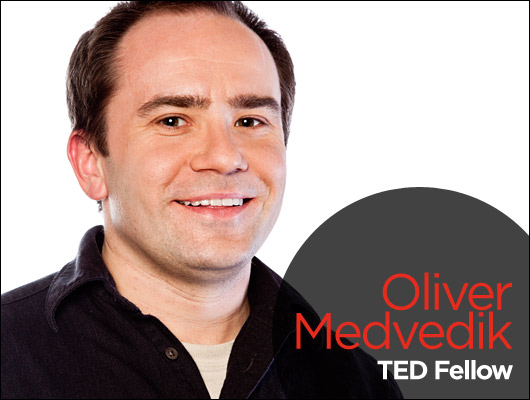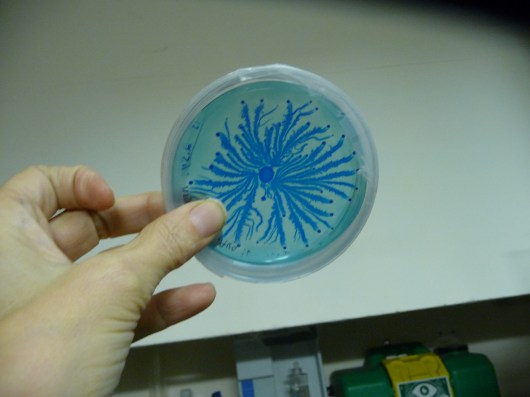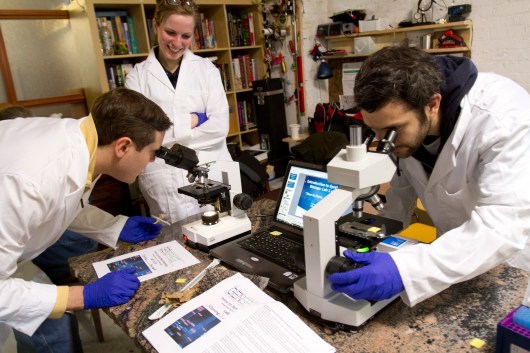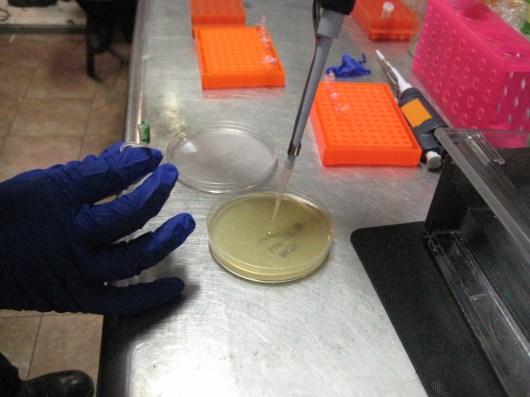
What is Genspace for?
In essence, Genspace, which is located in New York City, is for anybody wants to carry out a safe biotechnology project. To that end, we offer the space and the equipment. Through classes, we also offer the training. And we offer mentorship. So all of that comes with Genspace — but essentially it’s a space where you can do your work. There are not enough of these spaces around.
It sounds kind of like an art studio space, but for science.
Yeah. It’s also like a shared community garage or a shared machine shop. But now that the tools of biotech are getting cheaper and more available, it’s a space for biotech. We’ve got a whole assortment of people wanting to use the space — everybody from people who don’t know anything about biotech and decide to take classes and decide later, “It’s cool. I want to make a plant glow in the dark. Can we try it here?” to people who are bioartists who can’t get into academia to use their established lab because they’re already packed full with postdocs, to established researchers who have a lab, have a grant, but don’t want to do it in their institute for intellectual property reasons. They’d rather own their idea completely, and don’t want a university saying, “Well that’s a great idea, but we own it now, and we’ll give you 10 or 20 percent.” It’s a bit medieval. This tells me there’s a lot of great ideas out there that can now enter the marketplace that perhaps scientists had been withholding out of fear of losing ownership. Perhaps having more of these community labs means we may see more innovation as a result.
We also have young people, AP biology students — I’m talking about students in their early teens, 13 years old and up. Once you start a program that’s very hands-on and you have people who know what they’re doing more-or-less giving the classes, and you have fun, supervised projects, the kids pick things up really fast. And Genspace is very different from a typical educational establishment. Some of these students have taken some biotech courses, but what I think we offer here is much more immersive. Because we have much more flexible hours, classes go on longer, and it’s in a more realistic setting. We’ve basically built the lab to be a functional Level One biotech lab. They’re doing real biotech.
What’s the difference between biotech and synthetic biology, and how are these different from standard biology?
Biology is the entire field of life sciences. You don’t really need to have technology to study biology; you just need to have a notepad and your eyes and do field observations, do what Darwin did. It’s pure science. Biotechnology is the application of that information towards a technology, and it encompasses a broad range of technologies that involve the life sciences. That includes synthetic biology.
How do we jump to synthetic biology from biotech?
In biotech you can have something that’s almost purely biochemical and not even involve a life form. Gene sequencing, for example, is practically pure chemistry. You have an enzymatic based system which basically copies DNA. And you now have sophisticated electronic equipment that reads the genetic code. That’s part of biotech.
Synthetic biology is using whatever you’ve learned in biochemistry, sequencing technology and other techniques in the lab and altering them in such a way so as to have them create a novel characteristic that we as humans find useful. I would argue it’s one of mankind’s earliest technologies. All the food we eat, for example, going back to the beginning of agriculture, has been cultivated — has been created using artificial selection, only nature is doing the tinkering.
Now we have a way to go exactly, precisely into the genome and turn it on its head and say, well, instead of waiting for nature to create these random changes, now that we now have all the sequence data, we’ll go in and start making changes based on everything we know. Basically this will enable us to produce not just a bigger berry, but, if we can cross sequences from one organism to another, incorporate novel traits that we’ll find useful.
All of genetic engineering, all of biotech, is essentially biohacking. Nothing really new is created, it’s all basically modifications of what’s out there already. Mother Nature provides all the enzymes, all the raw sub-source code. And all these tools that are then sold by companies to cut DNA and swap pieces of DNA and do all of that, they all have analogs out in nature. The amount of genetic engineering that’s happening in nature is orders and orders and orders of magnitude more than that done by human hands in every genetic engineering lab put together.
Why is the biohacker movement gaining ground?
I think its prevalence is a matter of the timing and the accessibility of certain key components — equipment being one. Biotech didn’t really exist as we know it prior to the 1970s. All this equipment I can get cheaply on Ebay now, or is donated to us, used to be really hard to come by, even through the ’90s when I was still an undergrad, because it was still new, expensive equipment. It was hard to start a garage biotech when you needed 2 million dollars of seed money. But you can now buy a PCR machine for $100 on the internet because there are newer ones available.
A lot of other equipment is now available really cheaply secondhand. Instead of needing up to millions of dollars, it costs tens of thousands to set up a pretty well-equipped community biotech lab. A lot of the processes required can now be outsourced, too, services not available 20, 25 years ago.
But there also seems to be something about wanting to understand the nuts and bolts of science and technology that’s capturing public imagination.
As humans we learn with our senses. And probably our primary sense is touch. To learn, you need to do something tangible: act and create something. That gives you a richer context for learning. That’s where the fun part comes in. That’s what we like to encourage young people to realize: this isn’t an abstraction.
We’re in this competition called iGEM (International Genetically Engineered Machines Competition), where students have to produce genetically engineered microbes to do something. We have goals to meet. It’s like, we’re going to create this microbe here. We’re not going to sit around a table and discuss it. This is an engineering project. Why take someone else’s word for it when we extract DNA in less time than it takes a kid to read a paper on what DNA is? If they want to read the paper later, they can, but now they have this richer context and they’ll understand it.
So far, for every iGEM team that I’ve mentored, at least half the team of undergrads had zero formal biology training whatsoever. It was the first time they picked up a pipette or did PCR in their lives. And they were expected to engineer a microbe that the world has never seen before, test it and present it to the world at iGEM at MIT within the span of three months. What we’ve learned is, given the right environment with the right mentorship, that’s possible.
First the students come up with these crazy ideas. It just starts out with total ignorance. They come in and they’re like, “We’re going to create a microbe that we’ll inject it into a person’s bloodstream and it’ll give them super powers and cure all ailments, and we’ll do this in three months.” And we’re like, “Okay, cool. Find the literature on it and show me how doable you think that is within three months.” Then all of a sudden the scale shrinks and they reconsider, “Okay, we’ve got to scale that back, because we’re clearly nowhere near that technological state.” So that in and of itself is a learning experience. People do come up with really interesting, cool ideas, especially when they don’t have the background that makes them believe that certain things aren’t possible.
At the end of the summer, they have a much deeper understanding of biotech and its capabilities and where it’s going than they would have spending a year reading articles. Doing is fun. Some people don’t think it’s fun, but that’s fine too. I probably don’t think playing clarinet is fun. I don’t know, I haven’t tried. But you won’t know until you try, right?
But when you’re in the lab and you’re paying with microbes and DNA, you’re playing with something invisible in a little plastic tube, and then you put it in a machine and then you get a printout.
That’s what’s so frustrating about biotech is that it’s not like CSI! Well, I guess you could have rock music playing in the background.
But there are tangible results to work toward, as well. We have microbes smell like bananas and turn purple and glow in the dark. But there’s a certain route that you have to take. If you’re not focused on the end goal, then it’s boring. But that, I think, applies to every technical process. If you’re going to fix a car, you’ve got this lump of rusty stuff here and you’re like, “God, I’m going to have to spend 2,000 hours turning a screwdriver or a wrench.” It’s the same thing in molecular biology. I have to spend 2,000 hours squirting this one clear liquid into another clear liquid and hoping something happens in the end. That’s the frustrating part. And some people leave science because of that.
But by being very goal oriented, we’re not forcing you to take one route to get there. There’s more than one way to get a gene. You could clone directly from an organism, you could synthesize it from scratch chemically, you could use PCR to amplify it. You end up learning all of these “naturally” because you want to get to that endpoint. I think that’s part of what makes learning fun. I guess maybe that’s the definition of fun — doing something because you think the end result is worthy in some way.
How many community spaces are there like this? Were you the first one?
We were the first. There’s another one called BioCurious that started up in California. They’re actually very similar to what we do. But it’s all very nascent. Genspace and BioCurious are the only two community biotech labs, I would say, on the planet that I’m aware of that are at this stage of development. And we’re still at a very small stage even at Genspace. That’s another key ingredient to starting a successful space, is having at least one or two or more qualified people.
Why are people scared of community biohacker spaces?
The main worry people have is actually the wrong worry — that, oh, we’ll get these biohackers together and they don’t know what they’re doing and they’ll accidentally create something dangerous. The reality is is that you get a bunch of biohackers that don’t know what they’re doing and they won’t make anything, because it’s incredibly hard.
There are four safety categories of biology labs in the United States. Most labs are at Levels 1 and 2. Level 2 is pathogens, and Level 1 is basically high-school level. That’s what we are: everything we work with, the lifeforms, are non-pathogenic. All the genetic sequences are non-pathogenic sequences.
I think people don’t think about the numbers of microbes that we live with in our bodies and on every single surface. We’re sitting on the floor here…
On this filth. Yeah, basically. The interesting thing is that we’re a BSL one lab, but we’re surrounded by pretty much BSL two and perhaps three organisms all over the place — in the New York subway station and also in the building we’re in, just the random molds and spores. I would argue we’re probably the least pathogenic zone of the building that we’re in.
Tell us about your experience of being a TED Fellow.
The TED Fellows experience has been completely mind-blowing for me. Being able to communicate with the other Fellows on collaborations has been an immense boon to the types of projects that I can consider doing. Without my fellow Fellows, like Nina Tandon, I wouldn’t have been able to start my tissue engineering projects at our lab. Or talking with Jimmy Lin about setting up diagnostics workshops in our space. Working and being friends with the Fellows has been at the core of my experience with TED. Their motivation keeps me motivated. And of course, getting to showcase my work at a TED conference is a tremendous opportunity for exposure.



Comments (9)
Pingback: Kalpa Store
Pingback: A crowdfunding platform aims to solve the puzzle of aging
Pingback: なぜつくった?暗闇でも見える目薬を作る人たち | ソーシャルメディアまとめ
Pingback: DIY Biohack! Fellows Friday with Oliver Medvedik | TEDFellows Blog
Pingback: Exclusive video: How to make a cocktail from strawberry DNA | BizNax
Pingback: Exclusive video: How to make a cocktail from strawberry DNA
Pingback: Exclusive video: How to make a cocktail from strawberry DNA | BizBox B2B Social Site
Pingback: Exclusive video: How to make a cocktail from strawberry DNA | Best Science News
Pingback: Censorship, tiny robots, Mars: 20 TED Fellows on stage in Whistler | TEDFellows Blog